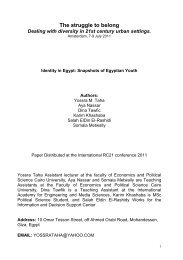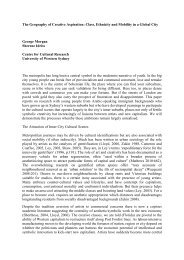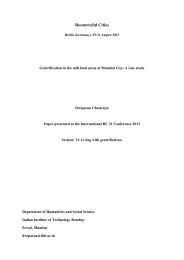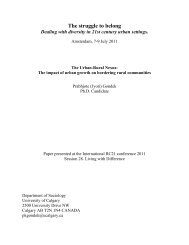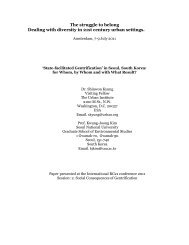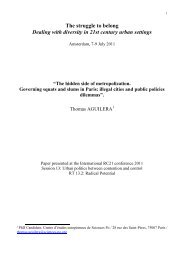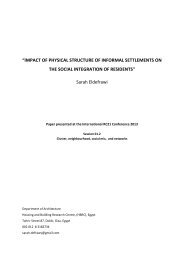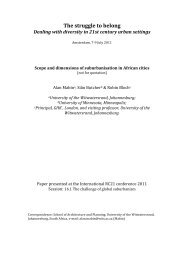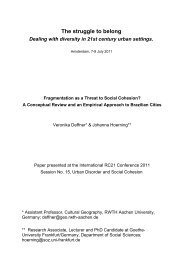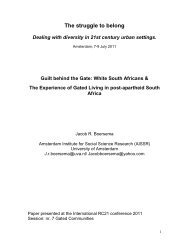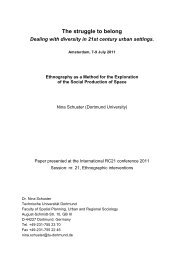Gentrification as a broad process of reurbanization - RC21 ORG ...
Gentrification as a broad process of reurbanization - RC21 ORG ...
Gentrification as a broad process of reurbanization - RC21 ORG ...
You also want an ePaper? Increase the reach of your titles
YUMPU automatically turns print PDFs into web optimized ePapers that Google loves.
Judit Veres CEU Budapest<br />
h<strong>as</strong> to change its pr<strong>of</strong>ile under the current leadership, choice that it is difficult to<br />
explain, or under a new leadership it will be something else. Either way it will ce<strong>as</strong>e<br />
to be Trafó <strong>as</strong> it is currently. The issue seems to be clear: the former Budapest<br />
leadership supported smaller and indipendent theaters and more alternative urban<br />
cultural spaces. The current leadership wants none <strong>of</strong> these.<br />
Trafó is the result <strong>of</strong> years <strong>of</strong> work and lobbying on the part <strong>of</strong> its current director. It<br />
is also the outcome <strong>of</strong> an urban political context that for twenty years w<strong>as</strong> led by a<br />
liberal mayor belonging to the Alliance <strong>of</strong> Free Democrats, one <strong>of</strong> the four parties that<br />
forged the democratic transition. No matter which party captured the state the capital<br />
w<strong>as</strong> run under a liberal leadership for twenty years. The political parties which<br />
dominated state institutions did affect the urban politics <strong>of</strong> the capital and many times<br />
it complicated their smooth functioning, nevertheless the liberal free democrats<br />
managed to keep the capital till 2010.<br />
A post-industrial cultural urban space builds up a narrative <strong>of</strong> a subversion<br />
Mills, granaries and electricity<br />
As a electric power transformer, Trafó‘s history goes back to the turn <strong>of</strong> the previous<br />
century. Three out <strong>of</strong> the five urban cultural spaces I proposed to look at are found in<br />
the ninth district <strong>of</strong> Budapest. In this piece <strong>as</strong> I already mentioned I focus on only one<br />
<strong>of</strong> them, namely Trafó. The other two MuPa and CET, the latter still under<br />
construction, and seemingly one <strong>of</strong> the first iconic buildings <strong>of</strong> the city, lie in the area<br />
<strong>of</strong> Ferencváros, where at the turn <strong>of</strong> the previous century rows <strong>of</strong> modern mills,<br />
granaries and warehouses used to be.<br />
The most decisive period in the urban development <strong>of</strong> Budapest, and Ferencváros, the<br />
ninth district <strong>of</strong> Budapest, is considered to be between the second half <strong>of</strong> the<br />
nineteenth century and the first quarter <strong>of</strong> the twentieth century.<br />
It is in the first quarter <strong>of</strong> the nineteenth century that crop and grain merchants start to<br />
get settled in large numbers in Pest, considered an important commercial centre. In<br />
the hope for larger pr<strong>of</strong>its these merchants start investing their accumulated capital<br />
into milling, making it the leading sector for the Hungarian industry for decades. The<br />
rows <strong>of</strong> the modern mills replacing the boat mills along the Danube become the<br />
symbol <strong>of</strong> the capital by the second half <strong>of</strong> the nineteenth century. The name <strong>of</strong> the<br />
9




